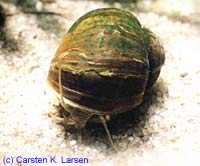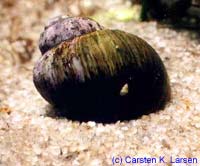|
Lanistes nyassanus
(Dohrn, 1865)
|
 Lanistes nyassanus from Cape MaClear in Lake Malawi. (picture not licenced under creative commons) |
 Lanistes nyassanus, same snail, other viewpoint. (picture not licenced under creative commons) |
 Lanistes nyassanus. (picture not licenced under creative commons) |
Shell: The snail form this genus
all have a hyperstrophic sinistral shell, which means the shell is sinistral,
bit the body of the snail is dextral.
The shell itself has an average size of about 50 mm height, but specimen with
a size of upt to 65 - 75 mm are not unusual. The shell itself is thick and heavy
in this species, with a low and depressed spire (depressed) and large aperture
(shell opening). The umbilicus is closed in adult snails, while very narrow
in young snails. The latter also have a much thinner shell.
There are no spiral bands on the brown shell surface.
Operculum: The operculum is corneous. The structure is concentric with
the nucleus near the centre of the shell.
Body: Brown foot with small light speckles equally distributed over the
sole and whole visible body.
Eggs: The aquatic eggs are encapsulated in a gelatinous mass and deposited
on the vegetation.
Food: Lanistes nyassanus eats algea from solid surfaces, in combination
with dead and decaying plant materials and occasionally it eats animal matter.
Habitat: Lanistes nyassanus resides on the Potamogeton
- Vallisneria vegetation at the sandy, shallow edges of the Lake Malawi
Lake.
In this lake there is a annual cycle of a hot, wet season (January-April) at
which the temperatures of the water can be 29°C and a dry, colder season
(June-August), in which the temperature drops to around 20°C.
Behaviour: This snail species is mostly active during the night (noctural).
During the day the snails are inactive and hide in the vegetation and the bottom.
This behaviour is probably an adaptation to avoid being predated on by the
molluscivorous cichlids in the lake, which hunt on vision.
Lanistes nyassanus is active throughout the whole year, and doesn't have
an aestivation period in, which the snails stays dormant in the mud.
As one realizes that Lake Malawi doesn't dry out, that the temperature stays
acceptable for these snails, and the fact that food can be found the whole year
round, on can imagine that there is no need to aestivate for these snails. Nevertheless,
the activity and number of snails vary with the seasons (less snails in the
cold, dry period). It has also been reported that these snails move to deeper
water (10 m) during the cold, dry season.
Distribution: Lanistes nyassanus is endemic (lives only here) to
Lake Malawi (Central Africa). Lanistes nasutus and Lanistes solidus
are also endemic to Lake Malawi.
Similar to: Lanistes nyassanus is closely related to Lanistes
solidus, Lanistes ellipticus
and Lanistes nasutus. The latter (nasutus) is found
in deeper places of the lake, is smaller (40 mm), has a thinner shell and has
a narrow umbilicus. The larger (up to 50 mm) Lanistes ellipticus
resides at the marshes surrounding Lake Malawi , and is not endemic to this
lake, but is distributed over whole Central and Southern Africa. Lanistes
solidus is much smaller and has an open,
although narrow umbilicus. Young Lanistes nyassanus snails also have
a open umbilicus, but have a thin and fragile shell as well, in contrast to
the heavy shell of Lanistes solidus.
Source of photographs: http://www.malawicarsten.dk/malawi%20dyr/posthornssnegle.htm
|
Except where otherwise noted, this page is licensed under a Creative Commons Attribution-NonCommercial-ShareAlike 2.5 License . http://www.applesnail.net |
|